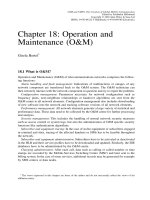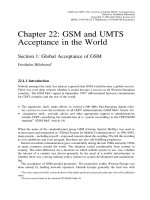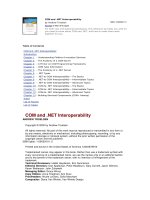Tài liệu Thermodynamics and Statistical Physics doc
Bạn đang xem bản rút gọn của tài liệu. Xem và tải ngay bản đầy đủ của tài liệu tại đây (2.8 MB, 27 trang )
PH605
Thermal and
Statistical Physics
M.J.D.Mallett
P.Blümler
Recommended text books:
• Finn C.B.P. : Thermal Physics
• Adkins C.J. : Equilibrium Thermodynamics
• Mandl F: Statistical Physics
PH605 : Thermal and Statistical Physics 2
14/02/2001
THERMODYNAMICS.....................................................................................................4
Review of Zeroth, First, Second and Third Laws...................................................4
Thermodynamics................................................................................................4
The zeroth law of thermodynamics,...................................................................4
Temperature, T...................................................................................................4
Heat, Q ...............................................................................................................4
Work, W.............................................................................................................4
Internal energy, U ..............................................................................................5
The first law of thermodynamics, ......................................................................5
Isothermal and Adiabatic Expansion .................................................................6
Heat Capacity.....................................................................................................6
Heat capacity at constant volume, C
V
................................................................7
Heat capacity at constant pressure, C
P
...............................................................7
Relationship between C
V
and C
P
.......................................................................8
The second law of thermodynamics, .................................................................8
Heat Engines ......................................................................................................9
Efficiency of a heat engine ..............................................................................10
The Carnot Cycle .............................................................................................11
The Otto Cycle.................................................................................................13
Concept of Entropy : relation to disorder............................................................15
The definition of Entropy.................................................................................16
Entropy related to heat capacity.......................................................................16
The entropy of a rubber band...........................................................................17
The third law of thermodynamics, ...................................................................18
The central equation of thermodynamics.........................................................18
The entropy of an ideal gas ..............................................................................18
Thermodynamic Potentials : internal energy, enthalpy, Helmholtz and Gibbs
functions, chemical potential ...............................................................................19
Internal energy .................................................................................................20
Enthalpy ...........................................................................................................20
Helmholtz free energy...................................................................................... 20
Gibbs free energy .............................................................................................21
Useful work......................................................................................................21
Chemical Potential ...........................................................................................22
The state functions in terms of each other .......................................................22
Differential relationships : the Maxwell relations...............................................23
Maxwell relation from U .................................................................................23
Maxwell relation from H .................................................................................24
Maxwell relation from F ..................................................................................24
Maxwell relation from G .................................................................................25
Use of the Maxwell Relations..........................................................................26
Applications to simple systems.............................................................................26
The thermodynamic derivation of Stefan’s Law .............................................27
Equilibrium conditions : phase changes..............................................................28
Phase changes ..................................................................................................28
P-T Diagrams ...................................................................................................29
PVT Surface.....................................................................................................29
First-Order phase change .................................................................................30
Second-Order phase change.............................................................................31
PH605 : Thermal and Statistical Physics 3
14/02/2001
Phase change caused by ice skates...................................................................31
The Clausius-Clayperon Equation for 1
st
order phase changes. ......................32
The Ehrenfest equation for 2
nd
order phase changes .......................................33
BASIC STATISTICAL CONCEPTS..................................................................................35
Isolated systems and the microcanonical ensemble : the Boltzmann-Planck
Entropy formula ...................................................................................................35
Why do we need statistical physics ?...............................................................35
Macrostates and Microstates............................................................................35
Classical vs Quantum.......................................................................................36
The thermodynamic probability, Ω..................................................................36
How many microstates ? ..................................................................................36
What is an ensemble ?......................................................................................37
Stirling’s Approximation .................................................................................39
Entropy and probability.......................................................................................39
The Boltzmann-Planck entropy formula..........................................................40
Entropy related to probability ..........................................................................40
The Schottky defect .........................................................................................41
Spin half systems and paramagnetism in solids...................................................43
Systems in thermal equilibrium and the canonical ensemble : the Boltzmann
distribution...........................................................................................................45
The Boltzmann distribution .............................................................................45
Single particle partition function, Z, and Z
N
for localised particles : relation to
Helmholtz function and other thermodynamic parameters .................................47
The single particle partition function, Z ..........................................................47
The partition function for localised particles ...................................................47
The N-particle partition function for distinguishable particles........................47
The N-particle partition function for indistinguishable particles.....................48
Helmholtz function ..........................................................................................49
Adiabatic cooling .............................................................................................50
Thermodynamic parameters in terms of Z.......................................................53
PH605 : Thermal and Statistical Physics 4
14/02/2001
Thermodynamics
Review of Zeroth, First, Second and Third Laws
Thermodynamics
Why study thermal and statistical physics ? What use is it ?
The zeroth law of thermodynamics,
If each of two systems is in thermal equilibrium with a third, then they are also in
thermal equilibrium with each other.
This implies the existence of a property called temperature. Two systems that
are in thermal equilibrium with each other must have the same temperature.
Temperature, T
The 0
th
law of thermodynamics implies the existence of a property of a system
which we shall call temperature, T.
Heat, Q
In general terms this is an amount of energy that is supplied to or removed
from a system. When a system absorbs or rejects heat the state of the system
must change to accommodate it. This will lead to a change in one or more of
the thermodynamic parameters of the system e.g. the temperature, T, the
volume, V, the pressure, P, etc.
Work, W
When a system has work done on it, or if it does work itself, then there is a
flow of energy either into or out of the system. This will also lead to a change
in one or more of the thermodynamics parameters of the system in the same
way that gaining or losing heat, Q, will cause a change in the state of the
system, so too will a change in the work, W, done on or by the system.
When dealing with gases, the work done is usually related to a change in the
volume, dV, of the gas. This is particularly apparent in a machine such as a
cars engine.
PH605 : Thermal and Statistical Physics 5
14/02/2001
Internal energy, U
The internal energy of a system is a measure of the total energy of the
system. If it were possible we could measure the position and velocity of every
particle of the system and calculate the total energy by summing up the
individual kinetic and potential energies.
11
NN
nn
UKEPE
==
=+
∑∑
However, this is not possible, so we are never able to measure the internal
energy of a system. What we can do is to measure a change in the internal
energy by recording the amount of energy either entering or leaving a system.
In general, when studying thermodynamics, we are interested in changes of
state of a system.
UQW∆=∆+∆
which we usually write,
dU Q W=+
đđ
The bar through the differential, đ , means that the differential is inexact, this
means that the differential is path dependent i.e. the actual value depends on
the route taken, not just the start and finish points.
The first law of thermodynamics,
PH605 : Thermal and Statistical Physics 6
14/02/2001
If a thermally isolated system is brought from one equilibrium state to another, the
work necessary to achieve this change is independent of the process used.
We can write this as,
Adiabatic
dU W= đ
Note : when we consider work done we have to decide on a sign convention.
By convention, work done on a system (energy gain by the system) is positive
and work done by the system (loss of energy by the system) is negative.
e.g.
• WPdV=+đ : compression of gas in a pump (T of gas increases).
• WPdV=−đ : expansion of gas in an engine (T of gas decreases).
Isothermal and Adiabatic Expansion
When we consider a gas expanding, there are two ways in which this can
occur, isothermally or adiabatically.
• Isothermal expansion : as it’s name implies this is when a gas
expands or contracts at a constant temperature (‘iso’-same, ‘therm’-
temperature). This can only occur if heat is absorbed or rejected by the
gas, respectively. The final and initial states of the system will be at the
same temperature.
• Adiabatic expansion : this is what happens when no heat is allowed
to enter or leave the system as it expands or contracts. The final and
initial states of the system will be at different temperatures.
Heat Capacity
As a system absorbs heat it changes its state (e.g. P,V,T) but different
systems behave individually as they absorb the same heat so there must be a
parameter governing the heat absorption, this is known as the heat capacity, C.
PH605 : Thermal and Statistical Physics 7
14/02/2001
The heat capacity of a material is defined as the limiting ration of the heat, Q,
absorbed, to the rise in temperature, ∆T, of the material. It is a measure of the
amount of heat required to increase the temperature of a system by a given
amount.
T0
limit
Q
C
T
∆→
=
∆
When a system absorbs heat its state changes to accommodate the increase
of internal energy, therefore we have to consider how the heat capacity of a
system is governed when there are restrictions placed upon how the system
can change.
In general we consider systems kept at constant volume and constant
temperature and investigate the heat capacities for these two cases.
Heat capacity at constant volume, C
V
If the volume of the system is kept fixed then no work is done and the heat
capacity can be written as,
V
V
U
C
T
∂
==
∂
V
đQ
dT
Heat capacity at constant pressure, C
P
The heat capacity at constant pressure is therefore analogously,
P
C =
P
đQ
dT
We now use a new state function known as enthalpy, H, (which we discuss
later).
H UPV
dH dU PdV VdP
dH Q VdP
=+
⇒=+ +
=+đ
Using this definition we can write,
P
P
H
C
T
∂
==
∂
P
đQ
dT
PH605 : Thermal and Statistical Physics 8
14/02/2001
Relationship between C
V
and C
P
The internal energy of a system can be written as,
-
dU Q W
QdUPdV
=+
⇒=
đđ
đ
Assuming the change of internal energy is a function of volume and
temperature, (,)UUVT= , i.e. we have a constant pressure process, this
can be written as,
TV
UU
QdVdTPdV
VT
∂∂
=++
∂∂
đ
which leads to,
P
P
TP V P
PV
TP
QUV U V
CP
dT V T T T
UV
CC P
VT
∂∂ ∂ ∂
⇒= = + +
∂∂ ∂ ∂
∂∂
∴=++
∂∂
đ
This is the general relationship between C
V
and C
P
.
In the case of an ideal gas the internal energy is independent of the volume
(there is zero interaction between gas particles), so the formula simplifies to,
P V
P
P V
V
CCP
T
CC R
∂
=+
∂
⇒−=
The second law of thermodynamics,
The Kelvin statement of the 2
nd
law can be written as,
It is impossible to construct a device that, operating in a cycle, will produce no
effect other than the extraction of heat from a single body at a uniform temperature
and the performance of an equivalent amount of work.
PH605 : Thermal and Statistical Physics 9
14/02/2001
A more concise form of this statement is,
A process whose only effect is the complete conversion of heat into work is
impossible.
Another form of the 2
nd
law is known as the Clausius statement,
It is impossible to construct a device that, operating in a cycle, will produce no
effect other than the transfer of heat from a colder to a hotter body.
Heat Engines
Heat engines convert internal energy to mechanical energy. We can consider
taking heat Q
H
from a hot reservoir at temperature T
H
and using it to do useful
work W, whilst discarding heat Q
C
to a cold reservoir T
C
.
PH605 : Thermal and Statistical Physics 10
14/02/2001
It would be useful to convert all the heat , Q
H
, extracted into useful work but
this is disallowed by the 2
nd
law of thermodynamics.
If this process were possible it would be possible to join two heat engines
together, whose sole effect was the transport of heat from a cold reservoir to a
hot reservoir.
Efficiency of a heat engine
We can define the efficiency of a heat engine as the ratio of the work done to
the heat extracted from the hot reservoir.
1
HC C
H HH
WQQ Q
QQ Q
η
−
== =−
From the definition of the absolute temperature scale
1
, we have the
relationship,
CH
CH
TT
=
1 For a proof of this see Finn CP, Thermal Physics,
PH605 : Thermal and Statistical Physics 11
14/02/2001
One way of demonstrating this result is the following. Consider two heat
engines which share a common heat reservoir. Engine 1 operates between T
1
and T
2
and engine 2 operates between T
2
and T
3
. We can say that there must
be a relationship between the ratio of the heat extracted/absorbed to the
temperature difference between the two reservoirs, i.e.
() () ()
'''
12 1
12 23 13
23 3
,, ,, ,
QQ Q
ff f
QQ Q
θθ θθ θθ== =
Therefore the overall heat engine can be considered as a combination of the
two individual engines.
( ) ( ) ( )
'' '
13 12 23
,,,fffθθ θθ θ θ=
However this can only be true if the functions factorize as,
()
()
()
,
x
xy
y
T
f
T
θ
θθ
θ
→
Where T(θ) represents a function of absolute, or thermodynamic temperature.
Therefore we have the relationship,
( )
()
1
1
22
T
Q
QT
θ
θ
=
Therefore we can also write the efficiency relation as,
1
C
H
T
T
η =−
The efficiency of a reversible heat engine depends upon the temperatures
between which it operates. The efficiency is always <1. The most efficient
heat engine is typified by the Carnot cycle.
The Carnot Cycle
PH605 : Thermal and Statistical Physics 12
14/02/2001
The Carnot cycle is a closed cycle which extracts heat Q
H
from a hot reservoir
and discards heat Q
C
into a cold reservoir while doing useful work, W. The
cycle operates around the cycle A►B►C►D►A
We can consider this cycle in terms of the expansion/contraction of an ideal
gas.
PH605 : Thermal and Statistical Physics 13
14/02/2001
A heat engine can also operate in reverse, extracting heat, Q
C
from a cold
reservoir and discarding heat, Q
H
, into a hot reservoir by having work done on
it, W, the total heat discarded into the hot reservoir is then,
HC
QQW=+
This is the principle of the refrigerator.
The Otto Cycle
The Carnot cycle represents the most efficient heat engine that we can
contrive. In reality it is unachievable.
Two of the most common heat engines are found in vehicles, the 4-stroke
petrol engine and the 4-stroke diesel engine.
The 4-stroke cycle can be considered as:
1. Induction : Petrol/Air mixture drawn into the engine cylinder.
2. Compression : Petrol/Air mixture compressed to a small volume by the
rising piston.
3. Power : Ignition of petrol/air mixture causes rapid expansion pushing
the piston down the cylinder
4. Exhaust : Exhaust gases evacuated from the cylinder by the rising
piston.
PH605 : Thermal and Statistical Physics 14
14/02/2001
The 4-stroke petrol engine follows the Otto cycle rather than the Carnot cycle.
The actual cycle differs slightly from the idealised cycle to accommodate the
introduction of fresh petrol/air mixture and the evacuation of exhaust gases.
The Otto cycle and the Diesel cycle can be approximated by PV diagrams.
Otto cycle
PH605 : Thermal and Statistical Physics 15
14/02/2001
Diesel cycle
Concept of Entropy : relation to disorder
We shall deal with the concept of entropy from both the thermodynamic and
the statistical mechanical aspects.
Suppose we have a reversible heat engine that absorbs heat Q
1
from a hot
reservoir at a temperature T
1
and discards heat Q
2
into a cold reservoir at a
temperature T
2
, then from the efficiency relation we have,
1 2
12
TT
=
but from the 2
nd
law we know that we cannot have a true reversible cycle,
there is always a heat loss, therefore we should rewrite this relationship as,
1 2
12
TT
<
The heat absorbed in one complete cycle of the heat engine is therefore,
0≤
∫
đQ
T
This is known as the Clausius inequality.
If we had a truly reversible heat engine then this would be,
PH605 : Thermal and Statistical Physics 16
14/02/2001
0
R
=
∫
đQ
T
The inequality of an irreversible process is a measure of the change of
entropy of the process.
final
final initial
initial
Q
SS S∆= − =
∫
đ
T
so for an infinitesimal part of the process we have,
dS ≥
đQ
T
The definition of Entropy
An entropy change in a system is defined as,
dS =
đQ
T
The entropy of a thermally isolated system increases in any irreversible process and
is unaltered in a reversible process. This is the principle increasing entropy.
The entropy of a system can be thought of as the inevitable loss of precision,
or order, going from one state to another. This has implications about the
direction of time.
The forward direction of time is that in which entropy increases – so we can
always deduce whether time is evolving backwards or forwards.
Although entropy in the Universe as a whole is increasing, on a local scale it
can be decreased – that is we can produce systems that are more precise –
or more ordered than those that produced them. An example of this is creating
a crystalline solid from amorphous components. The crystal is more ordered
and so has lower entropy than it’s precursors.
On a larger scale – life itself is an example of the reduction of entropy. Living
organisms are more complex and more ordered than their constituent atoms.
Entropy related to heat capacity
Suppose the heat capacity of a solid is C
P
=125.48 JK
-1
. What would be the
entropy change if the solid is heated from 273 K to 373 K ?
PH605 : Thermal and Statistical Physics 17
14/02/2001
Knowing the heat capacity of the solid and the rise in temperature we can
easily calculate the heat input and therefore the entropy change.
dS =
đQ
T
We integrate over the temperature range to determine the total entropy
change.
1
ln 39.2
final
initial
final
initial
T
final initial
T
T
P
T
final
P
initial
dQ
SS S
T
CdT
T
T
CJK
T
−
∆= − =
=
==
∫
∫
The entropy of a rubber band
A rubber band is a collection of long chain polymer molecules. In its relaxed
state the polymers are high disordered and entangled. The amount of disorder
is high and so the entropy of the system must be high.
If the rubber band is stretched then the polymers become less entangled and
align with the stretching force. They form a quasi-crystalline state. This is a
more ordered state and must therefore have a lower entropy.
The total entropy in the stretched state is made up of spatial and thermal
terms.
Total Spatial Thermal
SS S=+
If the tension in the band is rapidly reduced then we are performing an
adiabatic (no heat flow) change on the system. The total entropy must remain
unchanged since there is no heat flow, but the spatial entropy has increased
so the thermal entropy must decrease this means the temperature of the
rubber band drops.
Stretching force
PH605 : Thermal and Statistical Physics 18
14/02/2001
The third law of thermodynamics,
The entropy change in a process, between a pair of equilibrium states, associated
with a change in the external parameters tends to zero as the temperature
approaches absolute zero.
Or more succinctly,
The entropy of a closed system always increases.
An alternative form of the 3
rd
law given by Planck is,
The entropy of all perfect crystals is the same at absolute zero and may be taken as
zero.
In essence this is saying that at absolute zero there is only one possible state
for the system to exist in so there is no ambiguity about the possibility of it
existing in one of several different states.
This concept becomes more evident when we consider the statistical concept
of entropy.
The central equation of thermodynamics
The differential form of the first law of thermodynamics is,
dU Q W=+đđ
Using our definition for entropy and assuming we are dealing with a
compressible fluid we can write this as,
-
dU TdS PdV=
This is more usually written as,
TdS dU PdV
=+
This assumes that all the work done is due to changes of pressure, rather
than changes of magnetisation etc.
The entropy of an ideal gas
The specific heat capacity at constant volume for a gas is,
V
V
UdU
C
TdT
∂
==
∂
PH605 : Thermal and Statistical Physics 19
14/02/2001
Substituting this into the central equation gives,
V
TdS C dT PdV=+
If we consider one mole of an ideal gas and use lower case letters to refer to
molar quantities then we can write this as,
V
v
RT
Tds c dT dv
v
dT dv
ds c R
Tv
=+
=+
Integrating both sides gives us,
0
ln ln
v
sc TRvs=++
So the entropy of an ideal gas has three main terms,
1. A temperature term – related to the motion, and therefore kinetic
energy of the gas
2. A volume term – related to the positions of the gas particles
3. A constant term – the intrinsic disorder term which is un-measurable.
As an example of this can be used, consider gas inside a cylinder of volume,
V
0
. Suppose the volume of the cylinder is suddenly doubled. What is the
increase in entropy of the gas ?
Assuming this change occurs at constant temperature, we can write,
00
200
0
0
ln 2 ln
2
ln ln 2
VV
ss s R V RV
V
RR
V
∆= − = −
==
If we were dealing with more than one mole of gas we could write this as,
ln 2
ln 2
B
snR
Nk
∆=
=
Where n is the number of moles and N is the number of molecules. We will
return to this result when we look at the statistical definition of entropy.
Thermodynamic Potentials : internal energy, enthalpy, Helmholtz
and Gibbs functions, chemical potential
PH605 : Thermal and Statistical Physics 20
14/02/2001
The equilibrium conditions of a system are governed by the thermodynamic
potential functions. These potential functions tell us how the state of the
system will vary, given specific constraints.
The differential forms of the potentials are exact because we are now dealing
with the state of the system.
Internal energy
This is the total internal energy of a system and can be considered to be the
sum of the kinetic and potential energies of all the constituent parts of the
system.
11nn
UKEPE
∞∞
==
=+
∑∑
This quantity is poorly defined since we are unable to measure the individual
contributions of all the constituent parts of the system.
Using this definition of internal energy and the 2
nd
law of thermodynamics we
are able to combine the two together to give us one of the central equations of
thermodynamics,
TdS dU PdV
=+
This enables us to calculate changes to the internal energy of a system when
it undergoes a change of state.
dU TdS PdV=−
Enthalpy
This is sometimes erroneously called the heat content of a system. This is a
state function and is defined as,
H UPV=+
We are more interested in the change of enthalpy, dH, which is a measure of
the heat of reaction when a system changes state. In a mechanical system
this could be when we have a change in pressure or volume. In a
predominantly chemical system this could be due to the heat of reaction of a
change in the chemistry of the system.
dH dU PdV VdP=+ +
Helmholtz free energy









